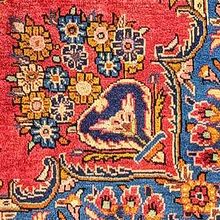Golpayegan Rug
| Golpayegan Rug | |
|---|---|
 Design of Golpayegan Rug (Rugman) | |
| General information | |
| Name | Golpayegan Rug |
| Original name | قالی گلپایگان |
| Alternative name(s) | Golpayegan Carpet |
| Origin | |
| Category | City |
| Technical information | |
| Common designs | Medallion, Afshan, Shah Abbasi, Islimi |
| Common colors | Red, Blue, Green, Beige, Ivory |
| Dyeing method | Natural, Synthetic |
| Pile material | Wool |
| Foundation material | Cotton |
| Knot type | Asymmetrical (Persian) |
Golpayegan Rugs, Golpayegan literally means “fortress of flowers” and is a small regional market center located between Hamedan and Tehran. In addition to being in a major agricultural region, Golpayegan is known for producing some of the world’s most beautiful area rugs. Due in large part to its proximity to Viss, they tend to produce similar types of area rugs. However, in comparison to others produced in the surrounding area, Golpayegan rugs are of a much finer quality. They certainly differentiate themselves with more intense colors and contrasts in addition to very attractive geometric shapes. Golpayegan rugs are woven using the asymmetrical knot with an average KPSI (knots per square inch) of 82.
History
Golpayegan is a town located in the Isfahan Province in central Iran. It is situated near three provinces, Arak (Markazi), Isfahan, and Qum, all of which are famous for carpet production. Carpets made in Golpayegan are known in the market from the twentieth century. The carpets imitated or were commissioned to use Qum and Farahan regional designs; Golpayegan weavings were marketed as Qum or Farahan carpets.
The carpets were considered lower in grade quality than original Qum or Farahan carpets, but in the late twentieth century Golpayegan weavers began to weave a finer quality, including rugs with a silk foundation and a silk pile. These weavings were similar to the finer-quality Qum carpets.[1]
See also
| Search for Golpayegan Rug on Wikipedia. |
References
- ↑ Moheban, 2015, 210
Bibliography
- Abraham Levi Moheban. 2015. The Encyclopedia of Antique Carpets: Twenty-Five Centuries of Weaving. NewYork: Princeton Architectural Press.